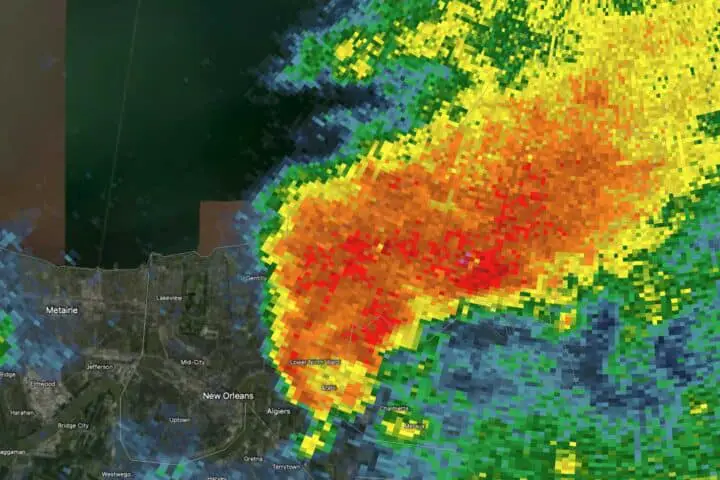On March 21-23, 2022, a multi-day severe weather and tornado outbreak with 78 confirmed tornadoes struck portions of the Deep South. The most affected areas were Texas and the eastern New Orleans metropolitan area northward into Mississippi. Major tornadoes included an EF3 to the east of New Orleans on March 23, another EF3 in Jacksboro, Texas that traveled 35+ miles on March 21, and an EF3 in Kemper, Mississippi on March 23.
However, as a result of the entire event being well-forecasted and well-warned, only two deaths were attributed to the outbreak despite its size.
Gretna-Arabi-eastern New Orleans tornado: March 23, 2022
The New Orleans tornado may have damaged as many as 12,500 structures as it passed through parts of the Lower Ninth Ward and was large enough to be seen from downtown sky cameras.
The hardest-hit areas were to the west of Arabi, where one died, and through the Michoud area. As the storm tracked away from the city, small debris was still falling out of the sky an hour later, one meteorologist noted on Twitter.
Texas Tornado Outbreak: March 21-22, 2022
The same storm system that triggered the New Orleans tornado swept through Texas, Oklahoma, and Arkansas on March 21 and 22 with at least a dozen tornadoes, storms continued through Alabama, Louisiana, and Mississippi with equal ferocity on the 23rd before the New Orleans tornado, which occurred toward the end of the outbreak.
Tornadoes tore through central Oklahoma south through Texas, including the Dallas and Austin metropolitan areas on the evening of the 21st. Meteorologists expected the 22nd to be worse, but much of the activity held off until the evening.
The first tornadoes struck mid-afternoon on March 21 in Jacksboro, Texas, about 60 miles northwest of Fort Worth. Another tornado followed in Round Rock north of Austin a few hours later, flipping a tractor-trailer as it crossed Interstate 45. Several other tornadoes struck other portions of central Texas, with at least one twister in Oklahoma later that night.
When we initially wrote this story, we also had a live blog. Please see the live blog below for more from the March 21-23 tornado outbreak.
What to Do if Severe Weather Strikes
If you have a weather radio, we strongly recommend ensuring its batteries are charged and set to alert you to warnings. Activate emergency warnings on your phone if you have disabled them, or ensure notifications for your favorite weather app are on. We prefer weather radios personally, as it is far less likely you’ll miss a warning due to loss of service or having notifications disabled.
If you’d like, you can review what each of the severe weather watches and warnings you might hear this week in the South means and what you can do to prepare for them:
What is a Tornado Outbreak?
While there is no set definition for a tornado outbreak, most meteorologists agree that more than 10 tornadoes in the same area within 24 hours are considered an outbreak. This varies by region, however: if a few tornadoes happen in an area where tornadoes are rare, meteorologists will often refer to these smaller events as tornado outbreaks, too.
Tornado outbreaks can be short-lived, lasting less than a day, or over several days. They most commonly happen in the Plains, Midwest, and South, however they can occur in the Mid-Atlantic and Northeast (however, far less frequently). These outbreaks are often only a small area of a larger area of severe weather, including large hail and damaging winds.



